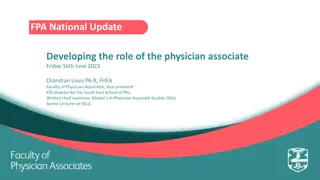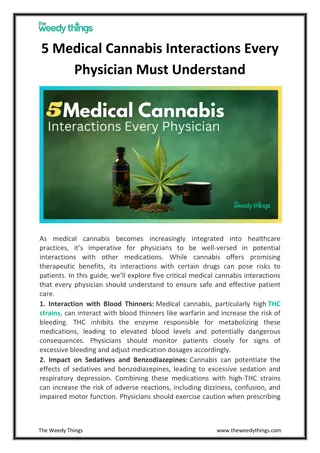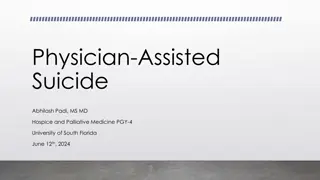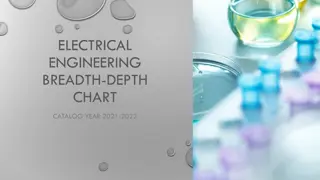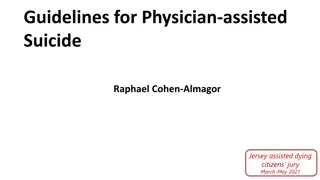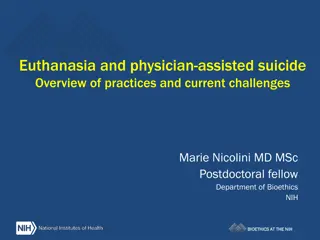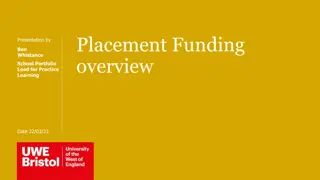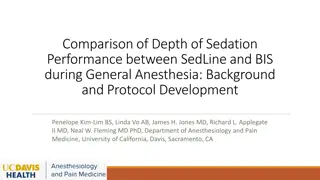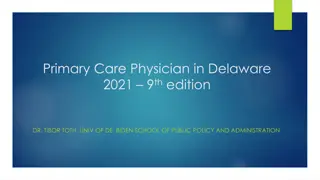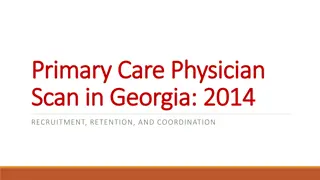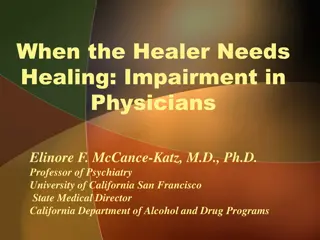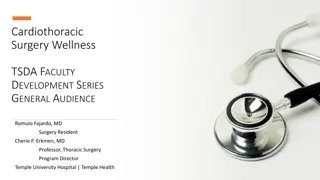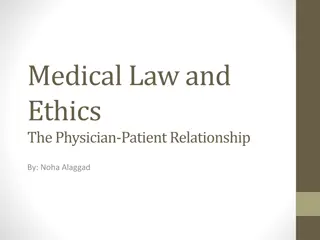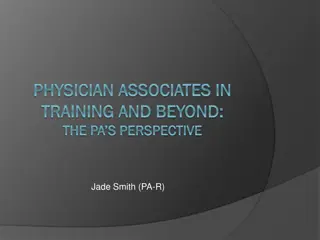Challenges in Physician Assistant Education: An In-depth Analysis
Identifying pre-matriculation predictors of success in Physician Assistant (PA) education is crucial for improving graduation rates. This study delves into the issues faced by PA programs, such as academic dismissal rates and the impact on academic reputation. It also discusses the financial, social, and emotional implications of student dropouts on universities and programs. By examining holistic factors like GPA, personality tests, and group work, this research aims to shed light on enhancing student success in PA schools.
- Physician Assistant Education
- Graduation Rates
- Academic Dismissal
- Student Dropout
- Holistic Assessment
Download Presentation

Please find below an Image/Link to download the presentation.
The content on the website is provided AS IS for your information and personal use only. It may not be sold, licensed, or shared on other websites without obtaining consent from the author. Download presentation by click this link. If you encounter any issues during the download, it is possible that the publisher has removed the file from their server.
E N D
Presentation Transcript
Doctoral Presentation OCTOBER 2020 TIFFANY FRAZIER
Research Topic Pre-Matriculation Predictors of Success in Physician Assistant Education (What makes students successful in PA school?)
Finding the PA Unicorn GPA Common-Sense Team-Player Compassion
Current Admissions Process Different for every PA Program Accreditation only requires us to follow our own admissions protocols A3.13 The program must define, publish, consistently apply and make readily available to prospective students, policies and procedures to include: admission and enrollment practices that favor specified individuals or groups (if applicable) a) b) admission requirements regarding prior education or work experience b) A3.14 The program must make student admission decisions in accordance with clearly defined and published practices of the institution and program.
Ok, so whats the problem? Each year the Physician Assistant Education Association (PAEA) collects data on physician assistant programs and publishes a yearly program report. Program Report 32 was published in 2016 and data showed 94.2% of students graduated from the PA program in which they started. What about the almost 6% that didn t graduate? The 2019 PAEA Program Report 34, for the 2018 academic year, cites that 111 programs (53% of programs) reported at least one student did not graduate or was not expected to graduate on time due to academic dismissal
Further defining the problem For the Program For the Student loss of academic reputation since PA programs report students lost as well as the first-time pass rate of the PANCE. Dropout has considerable financial, social, and emotional consequences and can cause great distress, low morale, and poor self-esteem issues with staff morale, as it is never easy to dismiss a student for academic reasons. Financially, this can also mean lost revenue to the university and the program in the form of lost-tuition.
CUW We try to look at the student from a wholistic approach Tuition roughly $45,000 for year one and $35,000 for year two= $80,000 5 students since first class matriculated in 2013 Cumulative Undergrad GPA Science Undergrad GPA CASPER Scores (personality test) Group Work Writing Samples Interview
Trends in Medicine Medicine is evolving, therefor the admissions process has to evolve Telemedicine Non-Cognitive attributes should be considered Empathy Maturity Professionalism
What does the research say? Strong association between Undergrad GPA and both PANCE score and PA Program GPA Pre-enrollment patient care is significantly associated with PANCE score but not necessarily program GPA Grades in pathophysiology and biochemistry were SIGNIFICANT predictors of higher PANCE scores PA School grades of A&P, Pharmacology
Non-Cognitive Findings The Netherlands has five government-funded PA programs. To be eligible for the programs, the student must already have a bachelor's degree in health care, at least two years of experience with direct patient care, and an employment contract with a hospital or specialty clinic. A study by van den Brink et al. compared all of the 184 students enrolled in the five programs combined to see if this traditional path was better or was there another way to predict success in the program. They compared these students with a group of students who took an assessment containing two tests: one a capacity test and the other focused on personality traits. The capacity test s purpose is a supposed estimate of one s intellectual level and ability to learn. The personality test looked at what the program called the Big Five : extraversion, agreeableness, conscientiousness, neuroticism, and openness to experience. Of the special cohort group with an assessment, 91% graduated. Of the group with a prerequisite bachelor's degree, 89% graduated
Non-Cognitive Continued The personality traits of successful students were summed up as grit by research done by Angela Lee Duckworth. Grit is loosely defined as responding resiliently to situations of failure and adversity or being a hard worker . Her research also concluded having consistent interests focused passions over a long time. That doesn t have anything to do with failure and adversity. It means that you choose to do a particular thing in life and choose to give up a lot of other things in order to do it. And you stick with those interests and goals over the long term. So, grit is not just having resilience in the face of failure, but also having deep commitments that you remain loyal to over many years.
What doesnt seem to matter? Age of student Gender of student GRE scores Undergraduate University Ranking **
PAEA Educational Forum 2017 Presidential Commission List of the most important characteristics for PA Students to Possess ethical responsibility Communication critical thinking situational judgment professionalism
Conclusion great grades in the undergraduate science classes has applicable hands-on experience possesses certain personality traits like adaptability, communication, and professionalism What the magic combination
CUW Take-away Points As applications to PA school increase, the challenge of choosing a future successful student becomes more difficult. We want success in didactic education but the ultimate goal of that education should be preparing students to be successful practitioners. Finding the combination for success while maintaining our niche in the PA community
What else can be done? given the implications student attrition has both on the academic institution as well as the student, and future patient-care, this is a topic that deserves more research Programs are currently able to view each other s prerequisites and enrollment practices. However, program-specific details, score sheets, or rubrics are not available. Programs do not share their admissions model Maybe we could? Specific Studies on Undergrad Science PreReqs Do we have a reliable way to test these Non-cognitive measures of success?? CASPER is currently being used We know WHAT is important but is any one of these factors MORE important than the others?
Resources 1.Physician Assistant Education Association, By the Numbers: Program Report 32: Data from the 2016 Program Survey,Washington, DC: PAEA; 2017. doi: 10.17538/PR32.2017 2. Physicians Assistant Education Association. By the Numbers: Program Report 34: Data from the 2018 Program Survery, Washington, DC. PAEA; 2018. https://paeaonline.org/wp- content/uploads/2019/10/program-report-34-20191002.pdf Accessed June 1, 2020 3.. Maher BM, Hynes H, Sweeney C, et al. Medical school attrition-beyond the statistics a ten year retrospective study. BMC Med Educ. 2013;13:13. Accessed Sep 4, 2019. doi: 10.1186/1472-6920-13-13 4. Butina M, Wyant AR, Remer R, Cardom R. Early predictors of students at risk of poor PANCE performance. J Physician Assist Educ. 2017;28(1):45-48. Accessed Nov 28, 2019. doi: 10.1097/JPA.0000000000000107 5.Goldgar C, Hills KJ, VanderMeulen SP, Snyder JA, Kohlhepp WC, Lane S. Using the core competencies for new physician assistant graduates to prioritize admission criteria for PA practice in 2025.J Physician Assist Educ. 2019;30(2):111-117. Accessed Nov 21, 2019. doi: 10.1097/JPA.0000000000000255 6. Standards of Accreditation: ARC-PA. ARC. http://www.arc-pa.org/accreditation/standards-of-accreditation/. Published February 18, 2020. Accessed March 14, 2020. 7.van den Brink, Geert Twj, Jans EG. Predictors of successful completion of the master of physician assistant studies in the netherlands. J Physician Assist Educ. 2018;29(3):135-137. Accessed Jul 23, 2019. doi: 10.1097/JPA.0000000000000216 8. Honda T, Patel-Junankar D, Baginski R, Scott R. Admissions variables: Predictors of physician assistant student success. J Physician Assist Educ. 2018;29(3):167-172. Accessed Jul 23, 2019. doi: 10.1097/JPA.0000000000000212 9. Andreeff R. Predictors of student success on the physician assistant national certifying examination. J Physician Assist Educ. 2014;25(3):36-39. http://cuw.ezproxy.switchinc.org/login?url=http://search.ebscohost.com/login.aspx?direct=true&AuthType=cookie,ip,cpid&custid=s7324964&db=mdc&AN=25650882&site=ehost-live&scope=site. Accessed Jul 23, 2019. 10. Brenneman AE, Goldgar C, Hills KJ, Snyder JH, VanderMeulen SP, Lane S. Noncognitive attributes in physician assistant education. J Physician Assist Educ (Lippincott Williams & Wilkins). 2018;29(1):25-34. Accessed Nov 21, 2019. doi: 10.1097/JPA.0000000000000187 11.Perkins-Gough D. The significance of grit: A conversation with angela lee duckworth. Educ Leadersh. 2013;71(1):14-20. http://cuw.ezproxy.switchinc.org/login?url=http://search.ebscohost.com/login.aspx?direct=true&AuthType=cookie,ip,cpid&custid=s3443150&db=eric&AN=EJ1032665&site=ehost-live&scope=site. Accessed Sep 4, 2019. 12. Home. CASPer. https://takecasper.com/. Accessed March 14, 2020.



